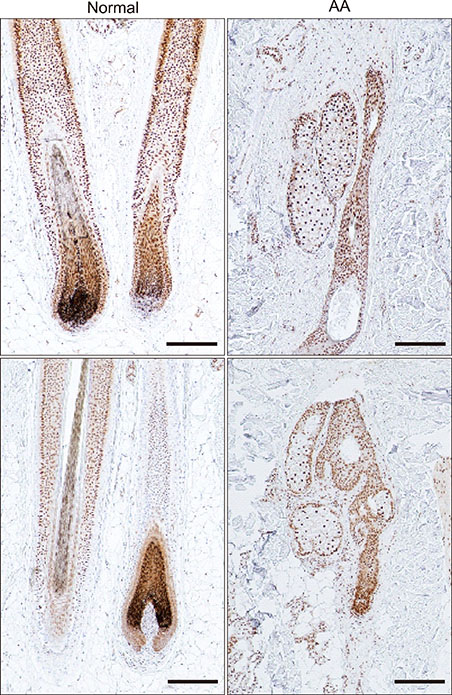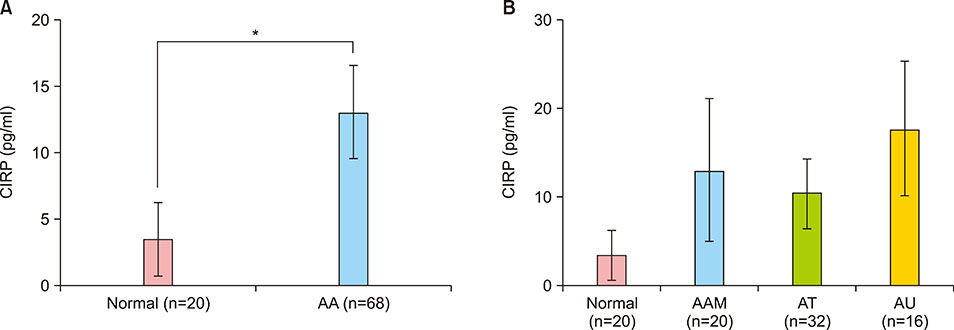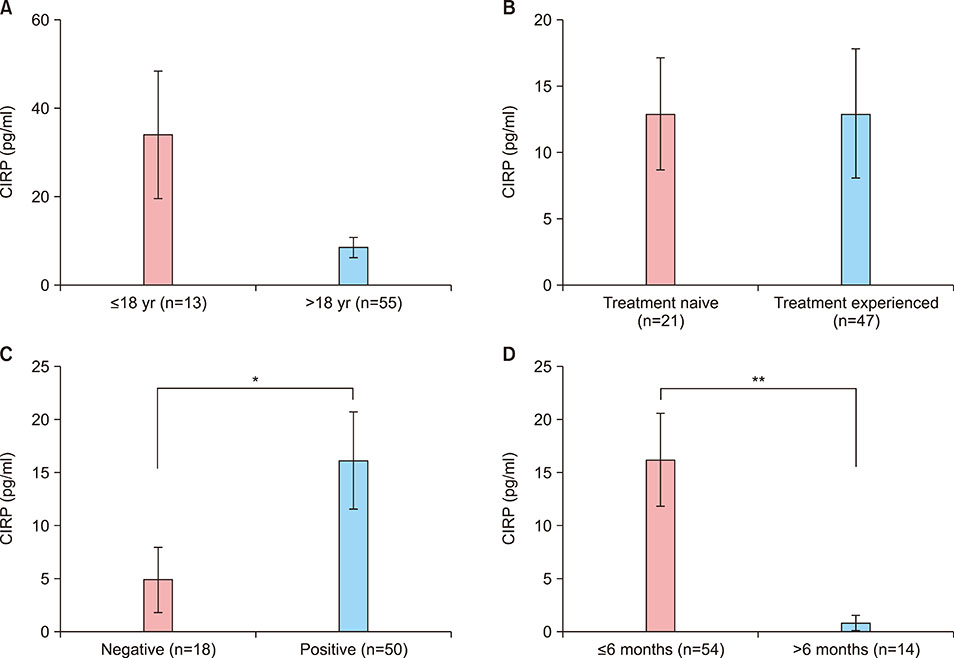Ann Dermatol.
2019 Aug;31(4):387-392. 10.5021/ad.2019.31.4.387.
Clinical Relevance for Serum Cold-Inducible RNA-Binding Protein Level in Alopecia Areata
- Affiliations
-
- 1Department of Dermatology, School of Medicine, Chungnam National University, Daejeon, Korea. gdpk1217@naver.com
- 2Clinical Trials Center, Chungnam National University Hospital, Daejeon, Korea.
- KMID: 2451475
- DOI: http://doi.org/10.5021/ad.2019.31.4.387
Abstract
- BACKGROUND
Alopecia areata (AA), a chronic, relapsing hair-loss disorder, is considered to be a T-cell-mediated autoimmune disease. Cold-inducible RNA-binding protein (CIRP) belongs to a family of cold-shock proteins that respond to cold stress, and has been identified as a damage-associated molecular pattern (DAMP) molecule that triggers the inflammatory response. Recent studies have shown that high-mobility group box 1, another DAMP molecule, is elevated in serum and scalp tissue of AA patients, suggesting a relationship between DAMP molecules and the pathogenesis of AA.
OBJECTIVE
To investigate the clinical significance of serum CIRP levels in AA.
METHODS
The serum levels of CIRP were compared between 68 patients with AA and 20 healthy controls. Additionally, the correlation between CIRP level and various clinical parameters was evaluated.
RESULTS
The serum CIRP levels were significantly higher in AA patients compared to healthy subjects. Moreover, there was an association between the serum CIRP level and clinical characteristics, such as disease duration and disease activity. However, there was no significant difference in the serum CIRP level among the clinical types of AA (AA multiplex, alopecia totalis, and alopecia universalis).
CONCLUSION
These results suggest that CIRP may play a significant role in the pathogenesis of AA and could be a potential biologic marker for monitoring the disease activity of AA.
MeSH Terms
Figure
Reference
-
1. Gilhar A, Etzioni A, Paus R. Alopecia areata. N Engl J Med. 2012; 366:1515–1525.
Article2. Islam N, Leung PS, Huntley AC, Gershwin ME. The autoimmune basis of alopecia areata: a comprehensive review. Autoimmun Rev. 2015; 14:81–89.
Article3. Milgraum SS, Mitchell AJ, Bacon GE, Rasmussen JE. Alopecia areata, endocrine function, and autoantibodies in patients 16 years of age or younger. J Am Acad Dermatol. 1987; 17:57–61.
Article4. Chu SY, Chen YJ, Tseng WC, Lin MW, Chen TJ, Hwang CY, et al. Comorbidity profiles among patients with alopecia areata: the importance of onset age, a nationwide population-based study. J Am Acad Dermatol. 2011; 65:949–956.
Article5. Chen CH, Wang KH, Lin HC, Chung SD. Follow-up study on the relationship between alopecia areata and risk of autoimmune diseases. J Dermatol. 2016; 43:228–229.
Article6. Han SS, Seo HM, Kim JS. Comorbid autoimmune diseases among patients with alopecia areata: a population-based case-control study in Korea. Korean J Dermatol. 2018; 56:30–35.7. McDonagh AJ, Tazi-Ahnini R. Epidemiology and genetics of alopecia areata. Clin Exp Dermatol. 2002; 27:405–409.
Article8. Qiang X, Yang WL, Wu R, Zhou M, Jacob A, Dong W, et al. Cold-inducible RNA-binding protein (CIRP) triggers inflammatory responses in hemorrhagic shock and sepsis. Nat Med. 2013; 19:1489–1495.
Article9. Nishiyama H, Itoh K, Kaneko Y, Kishishita M, Yoshida O, Fujita J. A glycine-rich RNA-binding protein mediating cold-inducible suppression of mammalian cell growth. J Cell Biol. 1997; 137:899–908.
Article10. Nishiyama H, Danno S, Kaneko Y, Itoh K, Yokoi H, Fukumoto M, et al. Decreased expression of cold-inducible RNA-binding protein (CIRP) in male germ cells at elevated temperature. Am J Pathol. 1998; 152:289–296.11. Nishiyama H, Higashitsuji H, Yokoi H, Itoh K, Danno S, Matsuda T, et al. Cloning and characterization of human CIRP (cold-inducible RNA-binding protein) cDNA and chromosomal assignment of the gene. Gene. 1997; 204:115–120.
Article12. Xue JH, Nonoguchi K, Fukumoto M, Sato T, Nishiyama H, Higashitsuji H, et al. Effects of ischemia and H2O2 on the cold stress protein CIRP expression in rat neuronal cells. Free Radic Biol Med. 1999; 27:1238–1244.
Article13. Wellmann S, Bührer C, Moderegger E, Zelmer A, Kirschner R, Koehne P, et al. Oxygen-regulated expression of the RNA-binding proteins RBM3 and CIRP by a HIF-1-independent mechanism. J Cell Sci. 2004; 117(Pt 9):1785–1794.
Article14. Sheikh MS, Carrier F, Papathanasiou MA, Hollander MC, Zhan Q, Yu K, et al. Identification of several human homologs of hamster DNA damage-inducible transcripts. Cloning and characterization of a novel UV-inducible cDNA that codes for a putative RNA-binding protein. J Biol Chem. 1997; 272:26720–26726.
Article15. Fein AM, Calalang-Colucci MG. Acute lung injury and acute respiratory distress syndrome in sepsis and septic shock. Crit Care Clin. 2000; 16:289–317.
Article16. Hoffmann R. The potential role of cytokines and T cells in alopecia areata. J Investig Dermatol Symp Proc. 1999; 4:235–238.
Article17. Philpott MP, Sanders DA, Bowen J, Kealey T. Effects of interleukins, colony-stimulating factor and tumour necrosis factor on human hair follicle growth in vitro: a possible role for interleukin-1 and tumour necrosis factor-alpha in alopecia areata. Br J Dermatol. 1996; 135:942–948.
Article18. Lee Y, Lee HE, Shin JM, Sohn KC, Im M, Kim CD, et al. Clinical significance of serum high-mobility group box 1 level in alopecia areata. J Am Acad Dermatol. 2013; 69:742–747.
Article19. Yoo IS, Lee SY, Park CK, Lee JC, Kim Y, Yoo SJ, et al. Serum and synovial fluid concentrations of cold-inducible RNA-binding protein in patients with rheumatoid arthritis. Int J Rheum Dis. 2018; 21:148–154.
Article20. Messenger AG, Bleehen SS. Alopecia areata: light and electron microscopic pathology of the regrowing white hair. Br J Dermatol. 1984; 110:155–162.
Article21. Jabbari A, Cerise JE, Chen JC, Mackay-Wiggan J, Duvic M, Price V, et al. Molecular signatures define alopecia areata subtypes and transcriptional biomarkers. EBioMedicine. 2016; 7:240–247.
Article22. Gregoriou S, Papafragkaki D, Kontochristopoulos G, Rallis E, Kalogeromitros D, Rigopoulos D. Cytokines and other mediators in alopecia areata. Mediators Inflamm. 2010; 2010:928030.
Article23. Bolognese AC, Sharma A, Yang WL, Nicastro J, Coppa GF, Wang P. Cold-inducible RNA-binding protein activates splenic T cells during sepsis in a TLR4-dependent manner. Cell Mol Immunol. 2018; 15:38–47.
Article24. Brochu C, Cabrita MA, Melanson BD, Hamill JD, Lau R, Pratt MA, et al. NF-κB-dependent role for cold-inducible RNA binding protein in regulating interleukin 1β. PLoS One. 2013; 8:e57426.
Article25. Loh SH, Moon HN, Lew BL, Sim WY. Role of T helper 17 cells and T regulatory cells in alopecia areata: comparison of lesion and serum cytokine between controls and patients. J Eur Acad Dermatol Venereol. 2018; 32:1028–1033.
Article26. Petukhova L, Duvic M, Hordinsky M, Norris D, Price V, Shimomura Y, et al. Genome-wide association study in alopecia areata implicates both innate and adaptive immunity. Nature. 2010; 466:113–117.
Article27. Betz RC, Petukhova L, Ripke S, Huang H, Menelaou A, Redler S, et al. Genome-wide meta-analysis in alopecia areata resolves HLA associations and reveals two new susceptibility loci. Nat Commun. 2015; 6:5966.
Article28. Yang WL, Sharma A, Wang Z, Li Z, Fan J, Wang P. Cold-inducible RNA-binding protein causes endothelial dysfunction via activation of Nlrp3 inflammasome. Sci Rep. 2016; 6:26571.
Article29. Shin JM, Choi DK, Sohn KC, Kim SY, Ha JM, Lee YH, et al. Double-stranded RNA induces inflammation via the NF-κB pathway and inflammasome activation in the outer root sheath cells of hair follicles. Sci Rep. 2017; 7:44127.
Article
- Full Text Links
- Actions
-
Cited
- CITED
-
- Close
- Share
- Similar articles
-
- A Case of Congenitally Developed Alopecia Areata
- The Therapeutic Effect and the Changed Serum Zinc Level after Zinc Supplementation in Alopecia Areata Patients Who Had a Low Serum Zinc Level
- Analysis of Serum Zinc and Copper Levels in Alopecia Areata
- A Case of Alopecia Areata in a Patient taking Cyclosporine
- The Changes of Autoantibodies against Hair Follicle in Alopecia Areata




